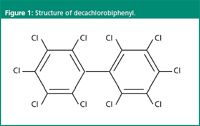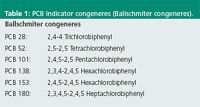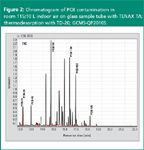School's Out For Renovation? Fast and Effective Determination of PCBs in Indoor Air Using Thermodesorption and GC–MS Analysis
The Application Notebook
Contamination of public buildings with PCBs used as softeners in the 1970's in sealants and wall and ceiling paints can still be detected. If certain threshold values in indoor air are exceeded the source has to be decontaminated. This requires an effective and fast determination of the PCB concentration in indoor air. Thermodesorption GC–MS is a method especially suitable for this purpose. Polychlorinated Biphenyls (PCBs) are highly toxic and carcinogenic chemical substances. Although first prepared in 1864, they have been industrially manufactured since 1929. The highest production amounts worldwide were recorded in the 1960s and the beginning of the 1970s. In the 1970s their use as additives for building materials was widespread because of their flame inhibiting and noise reduction properties.
Ulrich Servos,1 Dr Franz Kramp2 and Dr Margit Geissler,2
1 Shimadzu Deutschland GmbH, Duisburg, Germany,
2 Shimadzu Europa GmbH, Duisburg, Germany.
Contamination of public buildings with PCBs used as softeners in the 1970's in sealants and wall and ceiling paints can still be detected. If certain threshold values in indoor air are exceeded the source has to be decontaminated. This requires an effective and fast determination of the PCB concentration in indoor air. Thermodesorption GC–MS is a method especially suitable for this purpose. Polychlorinated Biphenyls (PCBs) are highly toxic and carcinogenic chemical substances. Although first prepared in 1864, they have been industrially manufactured since 1929. The highest production amounts worldwide were recorded in the 1960s and the beginning of the 1970s. In the 1970s their use as additives for building materials was widespread because of their flame inhibiting and noise reduction properties.
The use of PCBs in open systems was banned in Germany in 1978 after the eco-toxicity of PCBs became known. However, for closed systems (e.g., transformers) PCBs could still be used in Germany until 1989. The contamination of indoor air by PCBs can lead to chronic intoxication even with low PCB concentrations, especially if intake occurs over a longer period of time. Acknowledging this fact, a high level of responsibility concerning public buildings such as kindergardens, schools and administrative buildings is required.
A concentration of less than 300 ng/m3 of PCB in indoor air can be tolerated in the long-term, and this value is the target of decontamination works.1 For indoor air concentrations between 300 and 3000 ng PCB/m3 air the source of the contamination has to be found and eliminated medium-term. The target should be to achieve a concentration value of less than 300 ng PCB/m3 . At concentrations above 3000 ng PCB/m3 acute health risks are possible (level for immediate action).
Because of their persistence in the environment, their bio accumulation and potential for long range transport as well as their harmful effects on the environment and health, PCBs belong to the class of persistent organic pollutants (POP). Therefore, they fall under the Stockholm treaty for the removal of POPs from May 2001 which became effective on 17 May 2004.
Determination of PCBs
The determination of PCBs in indoor air is usually performed by GC–MS. After sampling on polyurethane foam a soxhelt extraction takes place for several hours.2 An alternative to this procedure is the method of thermodesorption. For sampling, special sample tubes are used, which are subsequently analysed with an autosampler, the so-called thermodesorber. In the thermodesorber the analytes are desorbed automatically from the sample tube and transferred to the GC–MS for analysis.
PCB-Analysis Using GC–MS
PCBs were used in the form of technical mixtures such as Chlophen A30, A40 and A60. These mixtures contain a large number of single compounds. Overall 209 congeners are possible. Depending on the chlorination degree the PCBs are numbered from 1 to 209, with the perchlorinated Decachlorobiphenyl being PCB 209 (Figure 1). Quantification of a PCB mixture is performed using certain PCB congeners as representative key compounds for the whole range of PCBs present in the mixture.

Figure 1
In indoor air analysis the so-called Ballschmiter Congeners are usually used (after Prof. Karlheinz Ballschmiter, Table1). The total concentration of the PCBs is calculated as five times the concentration of the sum of the Ballschmiter congeners (indicator congeners).1 Today the analysis of PCBs with GC–MS is a routine laboratory task. Separation of the compounds is performed on a GC column with low polarity. Analysis is performed in scan mode or in single ion monitoring (SIM) mode for higher sensitivity.

Table 1
Thermal Desorption of PCBs
PCBs belong to the group of semi-volatile compounds with a boiling point range of 270 °C to 420 °C. For quantitative analysis a high performance thermodesorption system is obviously required. In the TD-20 all parts coming into contact with the sample are inert and the flow path is completely thermally isolated. A Peltier cooling device used for a second stage packed cooling trap gives an optimal focusing of the sample, leading to correspondingly sharp peaks.
Inertness of the TD-20 was checked by running a second desorption on the same sample tube after desoprtion of a standard. Even with the PCB-180 and PCB-209 high boiling point compounds, no carryover effect was observed.
Calibration
An external standard calibration is used for quantitative analysis. A liquid standard sample, diluted in methanol is directly injected onto the conditioned sample tube. For each calibration level a sample tube is prepared. During and after injection the sample tube is flushed with inert gas ensuring that a complete transfer of the sample onto the adsorption material takes place. In this way also a real sampling of an indoor air sample with nitrogen as flushing gas can be simulated. 0.5 L nitrogen or 10 L nitrogen gas was used for flushing. The results show no significant influence of the amount of flushing gas used.
Indoor Air Samples
The real samples measured originated from an unused school building, which is currently being renovated. Sampling took place in three rooms with two samples simultaneously in each room. Using a sampling pump 250 mL/min were sampled on each tube for 40 min. The total volume was 10 L. An indoor air concentration of 300 ng/m3 in 10 L corresponds to 0.1 ng of each Ballsschmiter compound. Temperature of the rooms was 20 °C and the rooms were not vented prior to sampling.

Figure 2
Directly after sampling the sample tubes were automatically analysed using the Thermodesorption GC–MS system described and the PCBs were determined. Figure 2 shows the PCB distribution in a relatively highly contaminated room. All results are summarized in Table 2. Previous measurements showed results in the same range (room 112: 100–140 ng/m3 , room 115: 1100–3200 ng/m3 , room 121: no data available).

Table 2
Conclusions
Higher PCB concentrations can still be found in some public buildings in Germany. The sources of these contaminations are PCBs contained in paints and sealants. Analysis of PCB´s with GC–MS is a routine task, but sample preparation is time consuming and costly. The method of thermodesorption offers an excellent alternative. As no sample preparation is required and the method is completely automated, results can be obtained in minimal time. The comparatively high boiling point range of the PCBs requires a high performance thermodesorption system. In this application it could be shown that the TD-20 from Shimadzu fulfils all requirements such as inertness and optimal focusing needed for such a demanding application.
References
1. PCB-Richtlinie NRW, Richtlinie für die Bewertung und Sanierung PCB-belasteter Baustoffe und Bauteile in Gebäuden.
2. Geruchlos — doch gefährlich, PCB in Raumluft — Schnelle und selektive Analyse mit GCMS, Michael Kolloch, Analytis GmbH und Dr Ute Potyka, Shimadzu Deutschland GmbH. Shimadzu News 2/2004.
Shimadzu Europa GmbH
Albert-Hahn-Str. 6–10, 47269 Duisburg, Germany
tel. +49 203 7687 0 fax +49 203 766625
E-mail: shimadzu@shimadzu.de
Website: www.shimadzu.de


New Method Explored for the Detection of CECs in Crops Irrigated with Contaminated Water
April 30th 2025This new study presents a validated QuEChERS–LC-MS/MS method for detecting eight persistent, mobile, and toxic substances in escarole, tomatoes, and tomato leaves irrigated with contaminated water.
University of Tasmania Researchers Explore Haloacetic Acid Determiniation in Water with capLC–MS
April 29th 2025Haloacetic acid detection has become important when analyzing drinking and swimming pool water. University of Tasmania researchers have begun applying capillary liquid chromatography as a means of detecting these substances.

.png&w=3840&q=75)

.png&w=3840&q=75)



.png&w=3840&q=75)



.png&w=3840&q=75)









